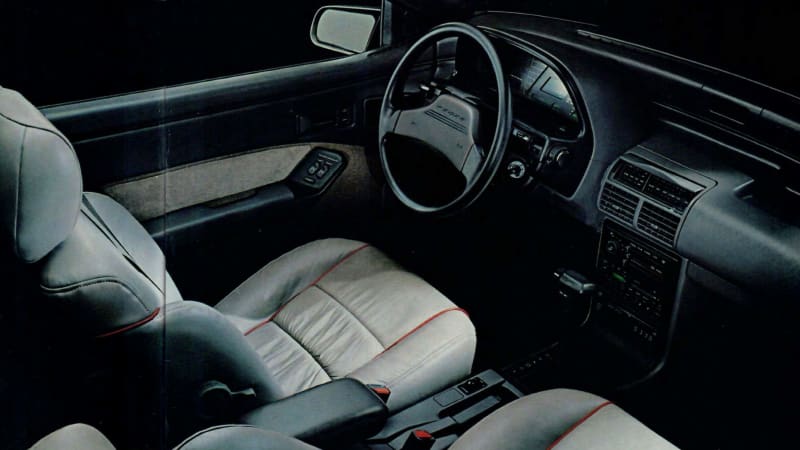The Ford Probe of the late Eighties was a litany of pluses and minuses.
On the plus side, chalk up the looks: svelte, sporty, aggressive. Put a check mark next to the intent box: the Probe initially was seen as an ambitious replacement for the Mustang. Then there was the involvement of Mazda in the Probe’s genesis. It would be built as part of a joint venture known as AutoAlliance International near Detroit, and offered with a 2.0-liter Mazda four cylinder, a similar powerplant boosted by a turbocharger, and later a 2.5-liter V6 generating 164 horsepower. The platform, drivetrain and suspension were all reliably Mazda, based on the company’s popular 626 sedan.



Now to the other side of the ledger. There were these reactions, more or less, to the “replace the Mustang” approach when Ford fanboys learned of the changes coming:
“Are you kidding?”
“You must be kidding.”
“You must be nuts!”
Why is the Ford Probe a future classic?
In the mid-Eighties, Ford’s scheme to introduce a redesigned Mustang — a classic in its portfolio for decades even then — was a dicey proposition, even before the redesign came to life. Because of exorbitantly high gas prices around 1980 — when the Probe-to-Mustang concept was conceived — Ford predicted gas-eaters like Mustang would soon disappear. Plus, it was deemed by Ford’s bean counters that a Probe would be cheaper to produce.
When formal details were leaked and released in 1987, the $13,000 Probe was cautiously applauded by the mass market, but thousands of Mustangers sent complaints to Ford. Jamming a four-cylinder in a “Mustang” would be heresy. Front-wheel drive? Not. And … naming it a Probe? Meh.
Neil Ressler, the then-chief of small car engineering at Ford, reflected afterwards on the different notions about what the Mustang should be: “There were a lot of people who thought that (the Probe) was a great idea — a modern car. There were also a lot of us who were appalled by that. It was like the champagne sipping crowd replaced the beer drinking crowd. The idea that we would replace the Mustang with a Japanese car — a different car from a different culture aimed at a different audience … this is not going to work.”
By 1997, less than 20,000 units had been delivered in Probe’s last-hurrah years. It’s official demise, prompted by sales of enthusiast-targeted cars like the Honda Prelude and Toyota Celica, was announced in March of that year. At the end, Ford had produced nearly 310,000 Probes over ten years on its Flat Rock, Michigan assembly line.
In the final analysis, the Probe was a “different strokes” story. Had it not been born as the anti-Mustang — it’s tough to dethrone a champion — its ultimate fate might’ve been kinder.
What is the ideal example of the Ford Probe?
The base mix-‘n-match model that went to market in the U.S. for 1989 (and sold alongside the Mustang) had, as mentioned, a 100-horsepower four. The slightly upscale GT version housed a turbo with 145 horses. It was cheered by critics for its agility and handling, streamlined looks and modest utility (the trunk was a wide liftback). A 3.0-liter V6 was an available option, and the engines could be paired with either a five-speed manual or four-speed automatic.
Second-generation models of the Ford Probe were released for 1993. As before, the Probe was to share its under-structure with Mazda’s MX-6 and 626, and the GT model was named “car of the year” by Motor Trend. Its redesign was led by Mimi Vanderholen, who was responsible for designing the Ford Taurus, and she tweaked the interior to make it more female-friendly, but the basic specs were unchanged. The top engine option on this second-generation model was a 24-valve dual-overhead-cam 2.5-liter V6 designed by Mazda that produced 164 horsepower.
Be sure to check out our used vehicle listings; they can be helpful for finding a good deal. You can narrow the options down by a radius around your ZIP code, and be sure to pay attention to the deal rating on each listing to see how a vehicle compares with others in a similar area.
Are there any good alternatives to the Ford Probe?
Although Ford pumped out more than 300,000 Probes over a decade, in the later years of the run the numbers shrunk, so that desirable late models are few and far between. The mechanically similar Mazda MX-6 isn’t any easier to find, either.
We found one available in Kansas, a 1994 GT five-speed with 81k miles, offered by a dealer for $11,000.
There’s a generous selection of alternatives, including the 1990 Mazda Miata, which proved that an imitation British sports car, built by Japan, could be reliable.
Also from Japan, the Nissan 300ZX, could be had with a 3.0-liter turbocharged V6 engine that made 300 HP and 283 lb-ft. of torque. And there’s the third-generation sports compact Honda Prelude, a (for the time) fascinating blend of technology, stuff like four-wheel steering. Also check out the upscale Prelude 2.0 Si, which incorporated a 2.0-liter DOHC four-cylinder with 135 horsepower and 127 lb-ft of torque. Some Preludes had tricky transmissions, so watch for odd noises and clunks.
